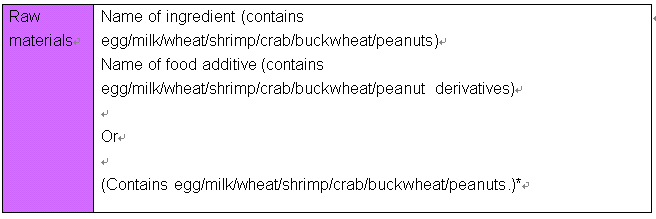Main content starts here.
Labelling of food with allergens
What is a food allergy?
A food allergy is when your body recognizes a specific food product as an unwanted foreign substance, and generates an over-sensitive reaction to protect itself.
The following symptoms may occur:
Skin conditions such as breaking out in hives or a rash; digestive symptoms such as diarrhea, vomiting, or abdominal pain; respiratory symptoms such as coughing or difficulty in breathing.
In serious reactions, your body may go into a state known as anaphylactic shock, which can be fatal without timely and proper treatment.
Food labelling
Ingredient labels on food products in Japan indicate which, if any, ingredients are considered allergens.
People with specific food allergies can check these food labels to see if food products contain allergens and whether they are safe to eat or not.
Ingredients which must be labeled – specific ingredients
- Eggs, milk, wheat, shrimp, and crab (due to being common allergy cases);
- Buckwheat and peanuts (due to the severity of allergic reactions).
Ingredients which are recommended to be labeled – quasi-specific ingredients
The following 20 foods containing allergens are recommended to be labeled as quasi-specific ingredients. Please note that they may not always be labeled:
- Abalone, squid, salmon roe, orange, cashew nuts, kiwi fruit, beef, chestnuts, sesame, salmon, mackerel, soybeans, chicken, banana, pork, matsutake mushroom, peach, Japanese yam (yamaimo), apple, and gelatin.
Table of food allergens(PDF:69KB)
Labeling methods in Japan
There are two patterns when labeling allergens; right after each ingredient name, or all together at the end.
Example: Japanese

Example: English

*May be written as “ingredients include egg/milk/wheat/shrimp/crab/buckwheat/peanuts” until March 31st 2020.